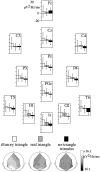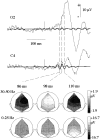Stimulus specificity of phase-locked and non-phase-locked 40 Hz visual responses in human
- PMID: 8753885
- PMCID: PMC6579008
- DOI: 10.1523/JNEUROSCI.16-13-04240.1996
Stimulus specificity of phase-locked and non-phase-locked 40 Hz visual responses in human
Abstract
Considerable interest has been raised by non-phase-locked episodes of synchronization in the gamma-band (30-60 Hz). One of their putative roles in the visual modality is feature-binding. We tested the stimulus specificity of high-frequency oscillations in humans using three types of visual stimuli: two coherent stimuli (a Kanizsa and a real triangle) and a noncoherent stimulus ("no-triangle stimulus"). The task of the subject was to count the occurrences of a curved illusory triangle. A time-frequency analysis of single-trial EEG data recorded from eight human subjects was performed to characterize phase-locked as well as non-phase-locked high-frequency activities. We found in early phase-locked 40 Hz component, maximal at electrodes Cz-C4, which does not vary with stimulation type. We describe a second 40 Hz component, appearing around 280 msec, that is not phase-locked to stimulus onset. This component is stronger in response to a coherent triangle, whether real or illusory: it could reflect, therefore, a mechanism of feature binding based on high-frequency synchronization. Because both the illusory and the real triangle are more target-like, it could also correspond to an oscillatory mechanism for testing the match between stimulus and target. At the same latencies, the low-frequency evoked response components phase-locked to stimulus onset behave differently, suggesting that low- and high-frequency activities have different functional roles.
Figures









References
-
- Bertrand B, Pantev C. Stimulus frequency dependence of the transient oscillatory auditory evoked responses (40 Hz) studied by electric and magnetic recordings in human. In: Pantev C, Elbert T, Lütkenhöner B, editors. Oscillatory event-related brain dynamics. Plenum; New York: 1994. pp. 135–146.
-
- Brosch M, Bauer R, Eckhorn R. Synchronous high-frequency oscillations in cat area 18. Eur J Neurosci. 1995;7:86–95. - PubMed
-
- Chatrian GE, Bickford RG, Uihlein A. Depth electrographic study of a fast rhythm evoked from the human calcarin region by steady illumination. Elec Clin Neurophysiol. 1960;12:167–176. - PubMed
-
- Conover WJ. Wiley; New York: 1980. Practical nonparametric statistics, 2nd Ed.
MeSH terms
LinkOut - more resources
Full Text Sources
Other Literature Sources
Miscellaneous
